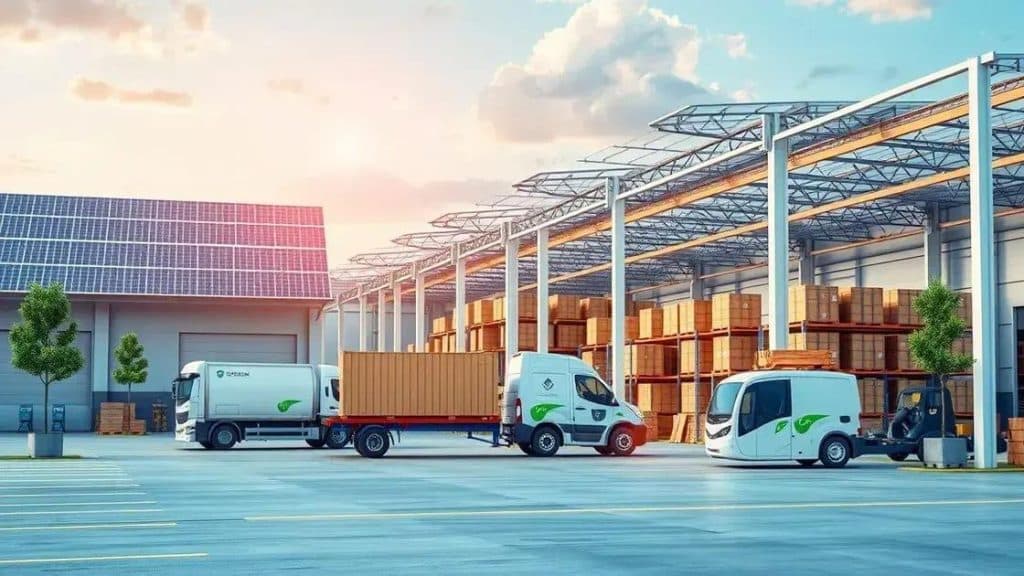Green supply chain optimization: Boost your efficiency today

Green supply chain optimization integrates sustainable practices in supply chains, reducing waste and costs while enhancing efficiency and brand image, as demonstrated by successful companies like Unilever and Procter & Gamble.
Green supply chain optimization is more than just a buzzword; it’s a crucial strategy for modern businesses aiming to balance efficiency and sustainability. Ever wondered how optimizing your supply chain can lead to cost savings and a healthier planet?
Understanding green supply chain optimization
Understanding green supply chain optimization is crucial for businesses that want to blend environmental responsibility with profitability. It involves innovative strategies to minimize waste and reduce carbon footprints.
This approach not only benefits the environment but can also lead to significant savings and improved brand reputation. Companies embracing this model are often viewed more favorably by consumers and investors alike.
Key Principles of Green Supply Chain Optimization
Green supply chain optimization focuses on various principles that guide businesses in making sustainable choices. These principles include:
- Minimizing waste through efficient use of resources.
- Utilizing eco-friendly materials in production.
- Implementing closed-loop systems to recycle products.
- Enhancing logistics to reduce carbon emissions.
Each of these principles plays a vital role in ensuring that supply chains are not only efficient but also aligned with sustainability goals. By fostering collaboration among suppliers, manufacturers, and retailers, businesses can drive significant change.
Another essential aspect is the adoption of technology. Tools like data analytics and AI enable companies to better forecast demand, optimize routes, and manage inventory efficiently. These advancements lead to reduced energy consumption and lower environmental impact.
Benefits of Implementing Green Practices
The benefits of implementing green supply chain practices are extensive. They include:
- Cost savings from reduced resource consumption.
- Improved compliance with regulations.
- Enhanced corporate image and customer loyalty.
- Better risk management through sustainable practices.
In conclusion, green supply chain optimization is a smart, forward-thinking choice. It presents a unique opportunity to create value while supporting the planet. Companies committed to these principles can enjoy a competitive edge in the marketplace.
Key benefits of sustainable supply chains

Key benefits of sustainable supply chains are numerous and impactful. Businesses that adopt sustainable practices often see improvements not only in their operations but also in their overall reputation. These practices contribute to a healthier planet while also driving profitability.
One significant advantage is cost savings. By reducing waste and optimizing resource use, companies can lower their operational costs. This can lead to a more stable financial situation, allowing for better investments and growth opportunities.
Improved Brand Image
Implementing sustainable practices enhances a company’s brand image. Consumers are increasingly conscious of their purchasing decisions. A commitment to sustainability can influence their choices positively. When customers see a brand caring for the environment, they are more likely to choose it over competitors.
- Increased customer loyalty.
- Attracting environmentally conscious consumers.
- Positive media coverage and publicity.
- Enhanced partnerships with like-minded businesses.
Another benefit is compliance with regulations. Many regions are tightening regulations related to environmental impact. Companies that proactively adopt sustainable practices are often ahead of the curve. They avoid costly fines and enhance their ability to operate smoothly.
Operational Efficiency
Operational efficiency also improves through sustainability initiatives. Streamlining processes leads to better use of resources. For example, using energy-efficient equipment can reduce energy consumption and costs simultaneously. Efficient logistics reduce transportation emissions, contributing further to sustainability goals.
In essence, embracing a sustainable supply chain isn’t just good for the environment; it creates substantial value for businesses. Companies can foster a culture of responsibility and innovation, driving overall improvements through these practices.
Tools and technologies for optimization
Tools and technologies for optimization play a vital role in enhancing green supply chain practices. Numerous innovative solutions are available that help companies achieve their sustainability goals while improving efficiency. These tools can streamline operations and reduce environmental impact.
Data analytics software is one of the key technologies that can transform supply chain management. By analyzing trends and patterns, businesses can make informed decisions. This leads to better demand forecasting, inventory management, and reduced waste.
Automation and Robotics
Automation technologies also contribute significantly to optimization. They streamline repetitive tasks, allowing companies to focus on strategic initiatives. Automation can enhance operational speed and accuracy. Examples of automation in supply chains include:
- Automated warehousing systems.
- Robotic process automation for order management.
- Smart inventory tracking solutions.
- Automated quality control measures.
Moreover, the Internet of Things (IoT) provides real-time data collection. Sensors and connected devices help monitor supply chain processes. This connectivity offers insights into every stage, from production to delivery. Companies can track emissions and energy use, leading to better optimization of resources.
Cloud-Based Solutions
Cloud computing is another game changer. It facilitates collaboration among partners throughout the supply chain. With cloud solutions, information is shared instantly. This leads to improved coordination and faster response times during disruptions. Companies can manage their operations from anywhere, enhancing flexibility.
In summary, utilizing modern tools and technologies is essential for companies aiming for sustainable supply chain optimization. Integrating these solutions not only enhances efficiency but also supports a commitment to environmental responsibility. Each technology plays a part in fostering a greener future.
Real-world examples of green supply chain success

Real-world examples of green supply chain success showcase how various companies have effectively integrated sustainability into their operations. These case studies provide valuable insights into best practices and innovative strategies.
One prominent example is Unilever. The company has committed to reducing its environmental footprint by improving its supply chain processes. Unilever launched a program called “Sustainable Living” which focuses on sourcing raw materials responsibly and reducing waste.
Procter & Gamble
Procter & Gamble (P&G) is another leader in sustainable supply chains. P&G aims to achieve a zero-waste goal in its manufacturing operations. The company has invested in improving its packaging to be more sustainable, using recycled materials and promoting recycling among consumers.
- Reduction of greenhouse gas emissions.
- Using 100% renewable energy in manufacturing facilities.
- Launching initiatives for water conservation.
- Collaboration with suppliers to enhance sustainability.
Furthermore, Walmart has made significant strides in its green supply chain strategy. They have implemented a project called “Project Gigaton,” which aims to eliminate one gigaton of greenhouse gases from their supply chain by 2030. This ambitious goal has led to improved supplier engagement and innovative practices.
Interface Inc.
Interface Inc., a flooring manufacturing company, is another notable example. They adopted a sustainability initiative called “Mission Zero,” aiming to eliminate any negative impact on the environment by 2020. Their innovations in materials and recycling processes have set a standard in the industry.
These case studies illustrate the tangible benefits of implementing green supply chain practices. Companies not only enhance their operational efficiency but also significantly improve their reputation and customer loyalty by committing to sustainability.
FAQ – Frequently Asked Questions about Green Supply Chain Optimization
What is green supply chain optimization?
Green supply chain optimization focuses on improving supply chain processes to enhance sustainability while reducing waste and costs.
What are some tools for optimizing a green supply chain?
Tools like data analytics software, automation technologies, and IoT devices can significantly enhance supply chain efficiency and sustainability.
How can adopting a green supply chain benefit my business?
It can lead to cost savings, a better brand image, compliance with regulations, and operational efficiency, making your business more competitive.
Can you give examples of companies with successful green supply chains?
Companies like Unilever, Procter & Gamble, and Walmart have implemented successful green supply chain practices that showcase significant environmental and business benefits.





